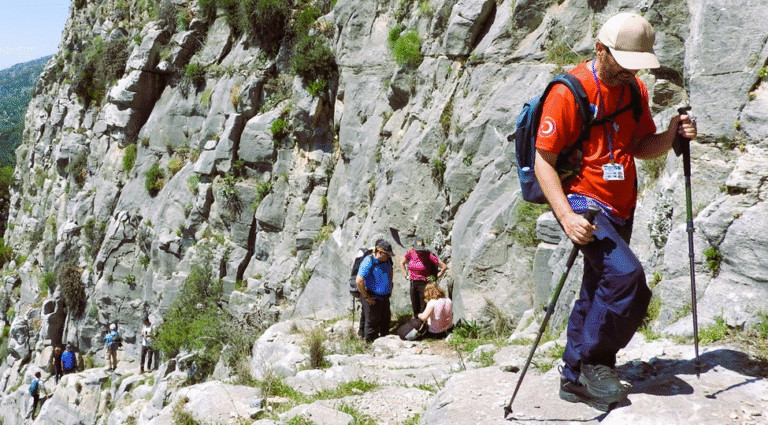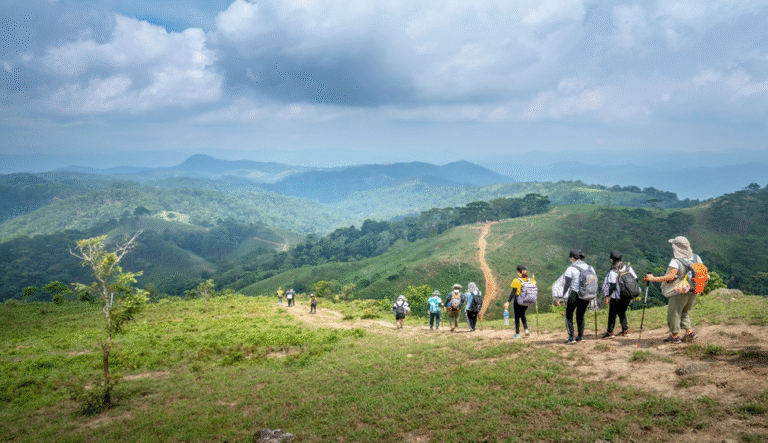
Trail etiquette is important for a good hiking trip. It keeps everyone safe, respectful and protects nature. Trail etiquette helps hikers, bikers, and riders share the trail nicely. Here are simple trail etiquette rules to follow.
1. Stay on the Trail
One important rule of trail etiquette is to stay on marked trails. Trails are made to protect nature. Going off-trail can hurt plants and cause erosion. Stay on the trail to keep animals safe.
2. Respect Right-of-Way
Trail etiquette includes right-of-way rules for a smooth hike. Hikers should move aside for horses, and bikers should move aside for both hikers and horses. This helps avoid confusion and accidents. When passing from behind, say hello to let others know you’re there.
3. Leave No Trace
“Leave no trace” is a guiding principle for all trail users. keep the trail the same way you found it. Take out everything you brought in, including trash. Don’t leave food scraps or other debris behind. Keep the trail clean and natural.
4. Keep Noise Low
Trail etiquette includes keeping noise low. Avoid loud music or shouting. Speak softly, and if you want music, use headphones. Many hikers enjoy the peace of nature, so keep sounds minimal.
5. Control Pets
Trail etiquette means controlling your pet. Keep dogs leashed, even if not required. Loose pets can disturb animals and hikers. Always clean up after your pet using waste bags. Dispose of them properly.
6. Yield to Uphill Traffic
Going uphill is often more challenging than descending. If you’re heading downhill, yield to those climbing up. Step aside and let them continue. This courtesy makes hiking less hard for those pushing uphill.
7. Respect Wildlife
Respecting wildlife is part of trail etiquette. Don’t feed wild animals. Animals and the environment can be harmed by feeding. Give animals space, keep quiet, and stop from making sudden movements.
8. Pass with Care
The goal of trail etiquette is to carefully pass other people. To alert them, say, “Passing on your left.” Take your time, especially on little roads, and don’t shock them. When passing, be considerate and cautious.
9. Stay Aware of Trail Conditions
Trail etiquette means protecting the trail. Wet or muddy paths can get damaged. Walk through mud, not around it, to keep trails narrow and safe. Avoid using trails in bad weather to prevent loss.
10. Minimize Trail Impact
Trail etiquette means protecting paths. Wear light clothes to avoid extra damage. Don’t drag poles—they can dig into the trail. Stay on the trail and avoid stepping on fragile areas. Every step count for keeping the trail safe.
11. Help in Emergencies
Emergencies can arise on any trail. If you come across someone in need, be willing to assist them. Carry basic first-aid supplies and be aware of the nearest medical institution. If an emergency occurs, keep calm and help to the best of your ability. Your activities may make a difference.
12. Follow Trail Rules
Rules vary from trail to trail. While some may forbid bikes, others may permit them. Before hiking, learn the rules. Following the rules keeps everyone safe and protects the trail. particular information, use trail apps, maps, or markers.
13. Share the Trail
The paths are open for everyone to enjoy. Sharing the trail requires respecting other people’s space and experiences. When you stop to rest, move to the side so others can pass. Avoid impeding the path, especially at popular spots. A cooperative attitude enhances the trail for all.
14. Plan Ahead
One aspect of trail etiquette is being well-prepared. Know how long and hard the trail is before you start. Bring appropriate clothing, drink, and snacks. Being prepared makes the trail safer for everyone and helps prevent issues.
15. Be Friendly and Courteous
A polite greeting goes a long way. Simple gestures stand-in a positive environment. Being respectful makes the trails more enjoyable for everyone. Don’t be bashful about greeting others, even if it’s just short. A good attitude improves everyone’s trail experience.
16. Avoid Crowded Times
Trail etiquette includes avoiding busy trails when possible. Go early or on weekdays to skip the crowds. This helps protect the trail and makes your hike quieter.
17. Practice Trail Safety
Trail etiquette means staying safe. Don’t climb risky rocks or leave the trail. Always use care and carry a map. Be prepared and look out for yourself and others.
18. Respect Trail Closures
Trail etiquette means respecting closures. Trails might close for repairs, weather, or preservation. Always check before starting. Stay off closed trails to avoid damage or danger.
19. Know When to Turn Back
Sometimes going back is the safest option. Bad weather, tiredness, or injuries can make hiking hard. There is no shame in going back if necessary. Listen to your body and choose options that promote safety.
20. Enjoy Nature Responsibly
The ultimate rule of trail etiquette is to enjoy nature responsibly. Every activity has an effect on the trail, its users, and wildlife. Take care of the paths, respect others, and enjoy the natural beauty around you.

Trail etiquette helps make hiking fun for everyone. Nature needs to be respected and protected. Every hiker, biker, and rider should keep trails safe and nice. Enjoy your hike and make it a great trip!
FAQ’s
Why is staying on the trail so important while hiking?
Who has the right of way on shared trails?
What does “leave no trace” mean?
How should I pass others on a narrow trail?
What should I do if I encounter wildlife while hiking?






